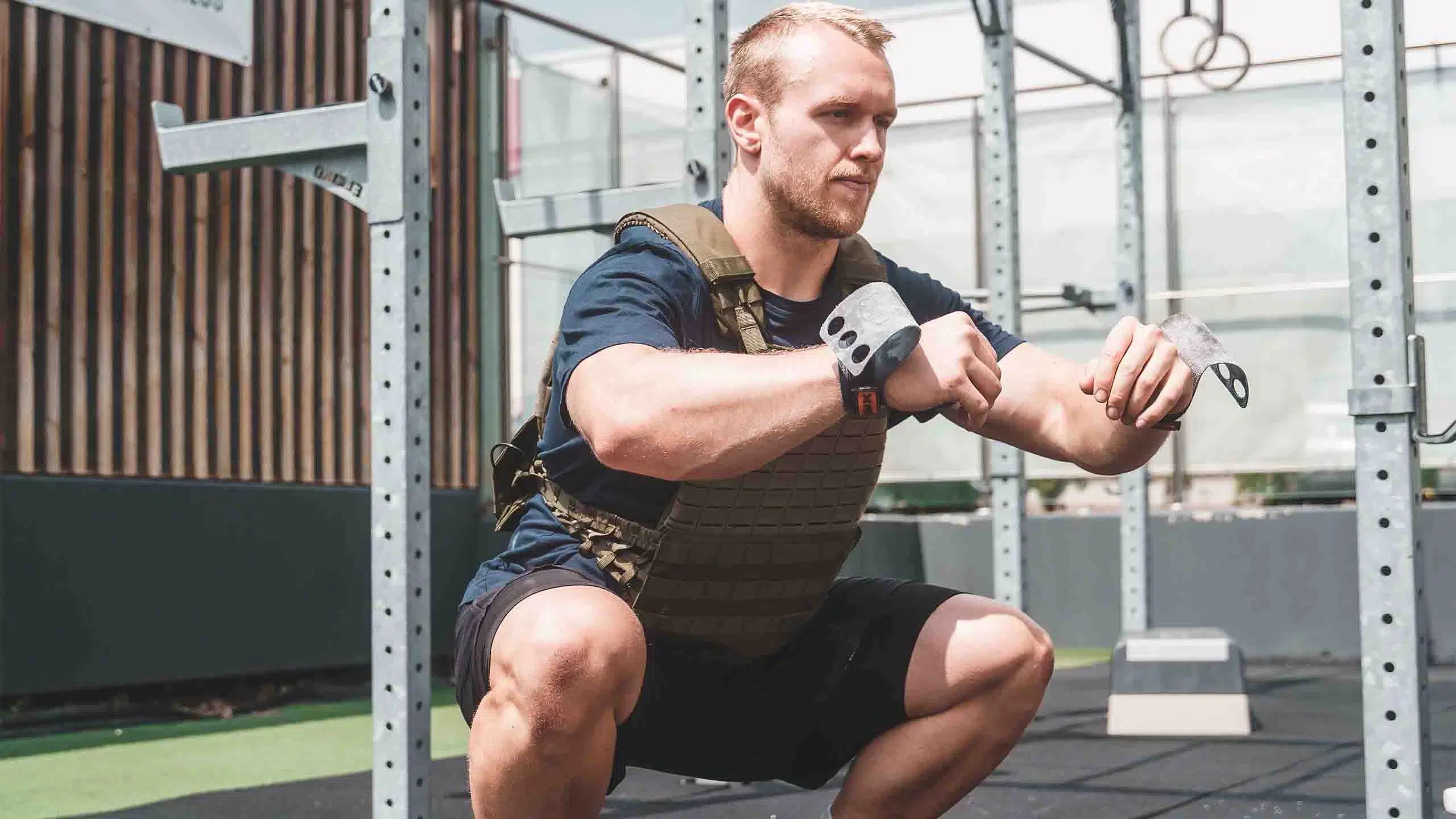Home>Misc>Featured>What Is The Different Between Interval Training And Crossfit


Featured
What Is The Different Between Interval Training And Crossfit
Modified: August 21, 2023
Learn the difference between interval training and CrossFit workouts. Discover the featured benefits and choose the right fitness routine for your goals.
Introduction
When it comes to fitness training, there are countless approaches and methods that cater to different goals and preferences. Among the most popular are interval training and CrossFit. These two forms of exercise have gained immense popularity in recent years due to their effectiveness in achieving fitness milestones and pushing the boundaries of physical capabilities.
Interval training is a widely recognized and utilized training method that involves alternating periods of high-intensity exercise with periods of rest or low-intensity activity. On the other hand, CrossFit is a high-intensity fitness program that combines elements of strength training, cardiovascular conditioning, and functional movements.
While both interval training and CrossFit share a focus on high-intensity workouts, they differ in several aspects, including the structure and programming, intensity and duration, equipment and exercises, as well as the training goals and objectives. Understanding the key differences between these two enticing methods can help individuals decide which approach aligns best with their fitness goals and preferences.
In this article, we will delve into the definition of interval training and CrossFit, explore their key differences and similarities, and discuss the benefits and drawbacks associated with each method. By gaining a deeper understanding of interval training and CrossFit, you will be better equipped to make an informed decision about which training style is most suitable for you.
Definition of Interval Training
Interval training is a training method that involves alternating between periods of high-intensity exercise and periods of rest or low-intensity activity. This approach is designed to push the body to its limits by challenging the cardiovascular system and improving overall endurance.
The high-intensity intervals in this training method are typically short bursts of intense exercise, such as sprinting or performing exercises at maximum effort. These intense intervals are followed by periods of active recovery or complete rest, allowing the body to partially or fully recover before the next high-intensity interval.
Interval training can be customized to fit different fitness levels and goals. For beginners, interval training may involve shorter intervals of high-intensity exercise, such as 30 seconds of intense activity followed by one minute of rest. As fitness levels increase, the duration and intensity of the intervals can be adjusted to create a more challenging workout.
This training method can be performed with various exercises, including running, cycling, swimming, or even bodyweight exercises. The flexibility of interval training allows individuals to tailor their workouts based on their preferences and the equipment available to them.
One of the key factors in interval training is the concept of intensity. By pushing the body to work at a high intensity during the intense intervals, individuals can reap the benefits of improved cardiovascular conditioning, increased calorie burn, and enhanced fat loss. Additionally, interval training has been shown to improve aerobic and anaerobic fitness, as well as boost overall endurance.
It is important to note that interval training should be approached with caution, especially for individuals who are new to exercise or have underlying health conditions. It is recommended to consult with a healthcare professional or a certified fitness trainer before incorporating interval training into a fitness routine.
Definition of CrossFit
CrossFit is a high-intensity fitness program that combines elements of strength training, cardiovascular conditioning, and functional movements. Developed by Greg Glassman in the early 2000s, CrossFit has gained a cult-like following and has become a global fitness phenomenon.
What sets CrossFit apart from traditional gym workouts is its emphasis on constantly varied, functional movements performed at high intensity. The workouts are designed to mimic real-life movements and activities, focusing on improving overall strength, endurance, flexibility, and power.
CrossFit workouts, often referred to as WODs (Workout of the Day), are typically short but intense. They involve performing a specific combination of exercises, known as the prescribed workout, within a set time frame. The WODs can incorporate a range of movements, such as weightlifting, gymnastics, plyometrics, running, rowing, and more.
One of the defining features of CrossFit is its sense of community. Many CrossFit enthusiasts train in group classes led by certified CrossFit trainers, creating a supportive and motivational environment. This communal atmosphere fosters friendly competition and encourages individuals to push their limits.
It is important to note that CrossFit is highly scalable and can be adapted to individuals of all fitness levels. Whether you are a beginner or an elite athlete, the workouts can be modified to suit your capabilities. The emphasis is not on the amount of weight lifted or the speed at which the exercises are performed, but rather on maintaining proper form and pushing yourself to your personal limits.
Although CrossFit has faced some criticism for the risk of injury due to its intense nature and emphasis on heavy lifting, proper technique and guidance from a qualified coach can greatly minimize this risk. It is crucial to focus on mastering the foundational movements and gradually progressing to more advanced exercises.
Overall, CrossFit offers a unique and challenging approach to fitness. It promotes functional strength, conditioning, and an overall improvement in physical performance. By incorporating elements of strength, endurance, and flexibility, CrossFit aims to create well-rounded individuals capable of tackling any physical challenge that comes their way.
Key Differences between Interval Training and Crossfit
While both interval training and CrossFit share a focus on high-intensity workouts, there are several key differences between the two methods. These differences lie in the focus and emphasis, structure and programming, intensity and duration, equipment and exercises, as well as the training goals and objectives.
Focus and Emphasis: Interval training primarily focuses on cardiovascular conditioning and endurance. It aims to improve aerobic and anaerobic fitness through short bursts of intense exercise. On the other hand, CrossFit places equal emphasis on strength training, cardiovascular endurance, and functional movements. It aims to create a well-rounded athlete capable of excelling in various physical activities.
Structure and Programming: Interval training typically involves structured intervals of high-intensity exercise followed by rest periods. The intervals can be customized based on fitness levels and goals. In contrast, CrossFit follows a daily workout regime known as the Workout of the Day (WOD). These WODs incorporate various exercises and movements, creating a constantly varied and challenging routine.
Intensity and Duration: Interval training workouts are short in duration but intense. The high-intensity intervals are often followed by shorter rest periods. CrossFit workouts, on the other hand, can vary in duration and intensity. They can range from a few minutes to several rounds, with varying intensity levels depending on the prescribed workout.
Equipment and Exercises: Interval training can be performed with minimal or no equipment, utilizing bodyweight exercises or simple cardio activities such as running or cycling. In contrast, CrossFit incorporates a wide variety of equipment, including barbells, kettlebells, rowing machines, and gymnastics apparatus. CrossFit workouts often involve a combination of weightlifting, cardio, and bodyweight exercises.
Training Goals and Objectives: Interval training aims to improve cardiovascular endurance, increase calorie burn, and enhance overall fitness levels. It is often used by athletes seeking to enhance their performance or individuals looking to lose weight. CrossFit, on the other hand, focuses on creating a well-rounded athlete capable of excelling in all physical domains, including strength, endurance, speed, agility, and flexibility.
While both interval training and CrossFit have their own unique benefits, it is important to choose a training method that aligns with your goals, preferences, and fitness level. Seeking guidance from a certified trainer can help you determine the most suitable approach for achieving your desired results.
Focus and Emphasis
The focus and emphasis of interval training and CrossFit differ in terms of the specific fitness components that they prioritize.
Interval Training: Interval training primarily focuses on cardiovascular conditioning and endurance. The main goal is to improve aerobic and anaerobic fitness through short bursts of intense exercise followed by periods of rest or low-intensity activity. By pushing the limits of the cardiovascular system, interval training aims to increase the capacity to perform at higher intensities and maintain a higher level of fitness.
Interval training is effective in improving the body’s ability to efficiently utilize oxygen and remove metabolic wastes during intense exercise. It also helps increase the body’s lactate threshold, allowing individuals to sustain higher levels of intensity for a longer duration. This type of training is particularly beneficial for athletes who participate in sports requiring bursts of energy, such as sprinting, basketball, or soccer.
CrossFit: Unlike interval training, CrossFit places equal emphasis on strength training, cardiovascular endurance, and functional movements. The goal of CrossFit is to create well-rounded athletes who excel in various physical challenges and activities. By incorporating elements of weightlifting, gymnastics, cardio, and bodyweight exercises, CrossFit aims to improve overall physical capacity and performance.
CrossFit workouts are designed to improve strength, power, agility, speed, flexibility, and stamina, all of which are crucial in performing daily activities and sports. The program aims to develop functional fitness, allowing individuals to meet the demands of real-life physical tasks, such as lifting objects, running, climbing, and jumping.
The emphasis on functional movements in CrossFit extends beyond the gym to enhance overall quality of life. By improving strength and mobility, individuals can experience benefits such as improved posture, decreased risk of injury, and increased overall physical ability.
While interval training focuses primarily on cardiovascular conditioning, CrossFit offers a more holistic approach by targeting multiple aspects of fitness. Whether your goal is to increase endurance, build strength, improve overall fitness, or enhance performance in various physical activities, understanding the different emphases of interval training and CrossFit can help guide you in choosing the training method that aligns best with your specific goals.
Structure and Programming
The structure and programming of interval training and CrossFit differ in terms of the organization of workouts and the approach to training.
Interval Training: Interval training typically involves structured intervals of high-intensity exercise followed by rest periods or periods of low-intensity activity. The intervals can be customized based on fitness levels and goals, allowing individuals to gradually increase the intensity or duration as they progress.
Interval training can be designed using various protocols, such as Tabata, HIIT (High-Intensity Interval Training), or Fartlek. The intervals can range from short bursts of 20 seconds to longer durations of several minutes, depending on the individual’s fitness level and desired outcomes.
The structure of interval training allows for flexibility and adaptation to different exercises and fitness equipment. It can be performed using bodyweight exercises, cardio activities such as running or cycling, or with the use of equipment like kettlebells or dumbbells.
CrossFit: CrossFit follows a daily workout regime known as the Workout of the Day (WOD). These WODs consist of a specific combination of exercises and movements that are completed within a set time frame or for a specific number of rounds. The workouts are constantly varying, incorporating different movements, equipment, and intensity levels.
The programming of CrossFit workouts is designed to challenge individuals in different domains of physical fitness, including strength, cardiovascular endurance, speed, agility, and flexibility. The variety in workouts helps prevent plateaus and keeps participants engaged and motivated.
CrossFit workouts often involve a mix of weightlifting, bodyweight exercises, cardio activities, and gymnastics movements. The use of functional movements and a wide range of equipment, such as barbells, kettlebells, rowing machines, and medicine balls, allows for a diverse and challenging training experience.
Both interval training and CrossFit provide structured approaches to training, but they differ in terms of the specific organization of workouts. Interval training focuses on alternating periods of high-intensity exercise and rest, while CrossFit utilizes constantly varied WODs to promote overall fitness and performance across multiple domains.
By understanding the differences in structure and programming between interval training and CrossFit, individuals can choose the training method that aligns with their preferences, goals, and desired training experience.
Intensity and Duration
Intensity and duration are two important factors that differentiate interval training and CrossFit in terms of the level of exertion and the length of time spent during workouts.
Interval Training: Interval training workouts are characterized by short bursts of high-intensity exercise followed by periods of rest or low-intensity activity. The high-intensity intervals are designed to push the limits of the cardiovascular system and challenge the body to perform at its maximum capacity.
The intensity of the intervals can be adjusted based on individual fitness levels and goals. Beginners may start with shorter, less intense intervals, while more advanced individuals can push themselves with longer and more challenging high-intensity intervals.
The duration of interval training workouts is relatively short, usually ranging from 10 to 30 minutes. This is attributed to the high intensity of the exercise, which places significant stress on the body. The short duration allows individuals to maximize their effort and maintain a high level of intensity throughout the workout.
CrossFit: CrossFit workouts can vary in intensity and duration, depending on the specific Workout of the Day (WOD) and the individual’s fitness level. The intensity of CrossFit workouts is typically high due to the emphasis on performing functional movements at a challenging pace.
The duration of CrossFit workouts can vary greatly, ranging from a few minutes to longer sessions. Some WODs may be completed for time, where the goal is to finish the workout as quickly as possible. Other WODs may involve completing a certain number of rounds or completing specific tasks within a set time frame.
In CrossFit, the intensity of the workout takes precedence over the duration. The focus is on completing the prescribed exercises with proper form and pushing oneself to their limits, regardless of the time it takes.
It is important to note that both interval training and CrossFit require individuals to work at a high level of intensity. This can lead to increased calorie burn, improved cardiovascular fitness, and enhanced fat loss.
The duration of the workouts in both interval training and CrossFit is relatively short compared to longer endurance activities like running or cycling. However, the intensity of the exercises and the high energy output compensate for the shorter duration, resulting in effective and efficient workouts.
By understanding the differences in intensity and duration between interval training and CrossFit, individuals can choose the training method that aligns with their fitness level, preferences, and availability of time for workouts.
Equipment and Exercises
The choice of equipment and exercises is a significant factor that distinguishes interval training from CrossFit. While both training methods focus on high-intensity workouts, the range of exercises and equipment used can vary.
Interval Training: Interval training can be performed with minimal or no equipment, making it accessible to individuals with limited resources or those who prefer bodyweight exercises. Exercises commonly used in interval training include running, jumping jacks, burpees, squat jumps, mountain climbers, and high knees.
In addition to bodyweight exercises, interval training can also incorporate equipment such as dumbbells, kettlebells, resistance bands, or cardio machines like treadmills or stationary bikes. The choice of equipment depends on individual preferences and the availability of resources.
Interval training allows for flexibility in exercise selection, enabling individuals to tailor their workouts to target specific muscle groups or fitness goals. This makes it suitable for a wide range of individuals, whether they prefer a gym setting or the convenience of home workouts.
CrossFit: CrossFit workouts incorporate a variety of equipment and exercises to challenge different muscle groups and improve overall functional fitness. The use of equipment is an integral part of CrossFit, providing resistance and adding intensity to the workouts.
Common equipment used in CrossFit includes barbells, dumbbells, kettlebells, medicine balls, rowing machines, plyometric boxes, gymnastics rings, pull-up bars, and more. These tools allow for a wide range of exercises such as Olympic lifts, squats, deadlifts, kettlebell swings, wall balls, handstand push-ups, and muscle-ups.
By utilizing equipment, CrossFit provides individuals with the opportunity to perform compound movements that engage multiple muscle groups simultaneously. This approach aims to improve strength, power, and overall functional capacity.
While equipment is an essential component of CrossFit, it is important to note that modifications and substitutions can be made to accommodate different fitness levels and accessibility to equipment. CrossFit offers scalability, allowing individuals to adapt exercises based on their capabilities and available resources.
The choice of equipment and exercises in both interval training and CrossFit ultimately depends on personal preferences, accessibility, and individual goals. Interval training offers versatility and the option for bodyweight or minimal equipment exercises, while CrossFit provides a broader range of equipment and compound movements to challenge individuals and promote functional fitness.
Training Goals and Objectives
The training goals and objectives of interval training and CrossFit differ in terms of the specific outcomes they aim to achieve and the focus on different aspects of fitness.
Interval Training: The primary goal of interval training is to improve cardiovascular endurance and overall fitness. By incorporating short bursts of high-intensity exercise followed by periods of rest or low-intensity activity, interval training challenges the cardiovascular system and pushes the body to adapt to increased intensity levels.
Interval training is particularly effective for improving aerobic and anaerobic fitness. It enhances the body’s ability to efficiently utilize oxygen, increases the lactate threshold, and promotes greater calorie burn during and after workouts.
Individuals who engage in interval training often aim to enhance their athletic performance, increase endurance, or lose weight. It is a popular choice for those who prefer shorter, more intense workouts that provide efficient results.
CrossFit: The main objective of CrossFit is to develop overall functional fitness. CrossFit workouts incorporate a wide range of movements and exercises to improve strength, power, cardiovascular endurance, flexibility, agility, coordination, and more. The program aims to create well-rounded athletes who excel in all physical domains.
While increased fitness and improved physique are common outcomes of CrossFit training, the emphasis goes beyond aesthetics. It trains individuals to perform well in real-life situations, such as lifting heavy objects, climbing stairs, or participating in sports activities.
Moreover, CrossFit fosters a sense of community and camaraderie, with individuals pushing and motivating each other to achieve their goals. The competitive nature of CrossFit can inspire individuals to strive for better performance and reach new fitness milestones.
The training goals and objectives of both interval training and CrossFit can be tailored to individual preferences and fitness levels. While interval training focuses on cardiovascular endurance and overall fitness, CrossFit aims to develop well-rounded athletes capable of excelling in various physical activities.
It is important to consider personal goals, preferences, and current fitness levels when choosing between interval training and CrossFit. Consulting with a certified trainer or fitness professional can provide guidance on which training method aligns best with your specific objectives.
Benefits and Drawbacks
Both interval training and CrossFit offer unique benefits, but they also come with their own set of drawbacks. Understanding these advantages and disadvantages can help individuals make an informed decision when choosing a training method.
Benefits of Interval Training:
- Time efficiency: Interval training allows individuals to achieve a high level of fitness in a shorter amount of time compared to traditional endurance training.
- Improved cardiovascular fitness: Interval training challenges the cardiovascular system, increasing aerobic and anaerobic capacity, and improving overall endurance.
- Calorie burn and fat loss: High-intensity intervals in interval training can lead to greater calorie burn during and after workouts, aiding in weight management and fat loss.
- Adaptability: Interval training can be customized to different fitness levels and goals, making it accessible to a wide range of individuals.
Drawbacks of Interval Training:
- Requires caution for beginners: The intense nature of interval training may be challenging for individuals who are new to exercise or have underlying health conditions. It is essential to start gradually and seek guidance from a healthcare professional or certified trainer.
- Potential for overexertion and injury: Pushing the body to its limits during high-intensity intervals increases the risk of overexertion and injury, especially if proper technique and form are not maintained.
- Less emphasis on strength training: Interval training primarily focuses on cardiovascular endurance and may not provide the same level of strength gains as programs specifically designed for strength training.
Benefits of CrossFit:
- Overall fitness improvement: CrossFit aims to develop well-rounded athletes by targeting multiple aspects of fitness, including strength, endurance, power, flexibility, and more.
- Functional movements and real-life applications: CrossFit incorporates functional movements that have practical applications in daily life, enhancing overall physical performance and functionality.
- Community and motivation: The sense of community and friendly competition in CrossFit classes can provide motivation, support, and accountability to individuals, making the training experience more enjoyable.
- Scalability: CrossFit workouts can be tailored to individual fitness levels, allowing beginners and elite athletes to participate and progress at their own pace.
Drawbacks of CrossFit:
- Potential for overtraining and injury: The high-intensity nature of CrossFit, combined with complex movements and heavy weights, increases the risk of overtraining and injury if proper form, technique, and recovery are not prioritized.
- Requires access to equipment: CrossFit workouts often involve the use of specialized equipment, making it necessary to have access to a well-equipped gym or training facility.
- Competitive atmosphere: While the competitive nature of CrossFit can be motivating, it may also lead to individuals pushing themselves beyond their limits, potentially resulting in overexertion and injury.
Considering the benefits and drawbacks of both interval training and CrossFit is crucial when deciding which training method aligns best with your goals, preferences, and fitness level. It is recommended to consult with a certified trainer or fitness professional who can provide personalized guidance and help you navigate through the training process safely and effectively.
Conclusion
In conclusion, interval training and CrossFit are two highly effective training methods that offer unique approaches to achieving fitness goals and pushing the limits of physical abilities. Both methods share a focus on high-intensity workouts, but they differ in terms of the focus and emphasis, structure and programming, intensity and duration, equipment and exercises, as well as the training goals and objectives.
Interval training primarily focuses on cardiovascular conditioning and endurance, utilizing short bursts of intense exercise followed by rest or low-intensity activity. It is efficient, customizable, and beneficial for improving aerobic and anaerobic fitness. Interval training is suitable for individuals looking for time-efficient workouts and those aiming to enhance endurance and burn calories.
CrossFit, on the other hand, takes a more holistic approach by focusing on strength training, cardiovascular endurance, and functional movements. It offers constantly varied, challenging workouts that enhance overall fitness, including strength, power, flexibility, and coordination. CrossFit is ideal for individuals seeking a well-rounded fitness program that prepares them for real-life physical challenges.
Both methods have their own benefits and drawbacks. Interval training offers time efficiency, adaptability, and improved cardiovascular fitness, but it may require caution for beginners and focuses less on strength training. CrossFit provides overall fitness improvement, functional movements, a sense of community, and scalability, but it requires access to equipment, may lead to overtraining or injury, and can have a competitive atmosphere.
Ultimately, the choice between interval training and CrossFit depends on individual preferences, fitness goals, and accessibility to equipment and training facilities. It is important to consider personal fitness levels, seek guidance from certified trainers or fitness professionals, and gradually progress in intensity and difficulty.
Regardless of the chosen training method, consistency, proper form, and adequate recovery are essential for maximizing the benefits and minimizing the risks of injury. It is advisable to listen to the body, prioritize rest and recovery, and consult with professionals when needed.
By understanding the key differences and considering individual needs, individuals can select the training method that suits their goals and preferences, supporting them on their fitness journey and helping them achieve their desired level of fitness and well-being.








